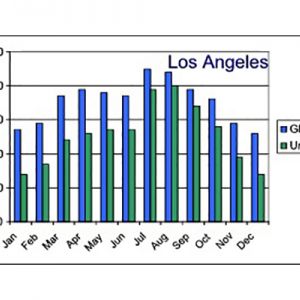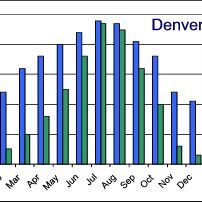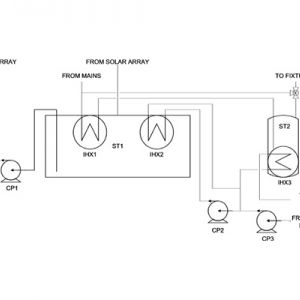General Layout of Year-Round Pool Systems
SunEarth advocates the use of indirect systems and custom commercial solar water heaters with glazed panels for pools operated year round for several reasons: The first reason is simple, annual output of glazed systems is 30-70% greater than unglazed systems. For seasonal pools, unglazed collectors perform on par with their glazed counterparts. During the cooler winter season however, glazed panels maintain their output while that of unglazed units drops dramatically.
The figures on the right show system outputs for a 1,200 sq. ft array of our EP series vs. the average plastic pool panel calculated with F-chart. The pool is 1,500 sq. ft. without a cover and located indoors. The output of the glazed units is 38% greater for Los Angeles and 68% greater for Denver.
Array Layout
The array for a indirect pool system looks just like that of a indirect DHW system. The array has isolation valves that can be used to bring down any row without affecting the others, and the valve on the outlet of the array may be used for balancing.
The air vent may be either an automatic or coin vent to eliminate trapped or dissolved air in the glycol.
Inter-Tie With the Pool
The mechanicals for a indirect pool system again resemble those of a indirect DHW system on the collector side. There are drain and fill valves, a circulator, and expansion tank to regulate pressure in the loop. Whereas we would find the heat exchanger connected to a storage tank in a DHW system, we simply find it connected to the pool here. The heat exchanger is connected with balancing and bypass valves to the main filter line. Typically valves BV3 and BV5 are open with valve BV4 closed to divert the flow through the heat exchanger before going into the boiler. The position of these valves can be reversed to isolate the heat exchanger for de-scaling or repair.
The only control for this type of system is a siomple differential temperature controller with sensors located on the pool filter line before the heat exchanger and on the outlet header on one of the rows. When the controller senses that the collectors are hotter than the pool it energizes the solar pump P1. When there is no energy to be collected, pump P1 stops and the pool water simply passes through the heat exchanger unchanged as though the solar system were not even there.
Sizing the Heat Exchangers
Due to the high flow rates found in pool filter circuits, tube-in-shell units are usually preferred over brazed plate units. In addition to the smaller B-130 and B-180 used in DHW and spa applications, we have units several times larger for pool applications of 40 panel arrays. The table below lists the tube in shell units, their dimensions and the maximum array area they can handle while maintaining performance on par with direct designs.
This heat exchangers are also well suited to solar pool and spa applications, Due to the high flow rates found in pool filter circuits, tube-in-shell units are usually preferred over brazed plate units. The table below lists the tube in shell units, their dimensions and the maximum array area they can handle while maintaining performance on par with direct designs. The standard tube in shell unit are constructed of 316L Stainless Steel, which has excellent corrosion resistance to chlorinated pool water provided the chemical balance an pH of the pool water is closely regulated. Titanium heat exchangers are significantly more expensive, but have superior chemical resistance. For salt water pools and spas, titanium heat exchangers are required.
The standard tube in shell unit are constructed of 316L Stainless Steel, which has excellent corrosion resistance to chlorinated pool water provided the chemical balance an pH of the pool water is closely regulated. Titanium heat exchangers are significantly more expensive, but have superior chemical resistance. For salt water pools and spas, titanium heat exchangers are required.
| SunEarth Model Number | Diameter (in) | Length (in) | Heat Transfer Area (sq ft) | Maximum Array Area (sq ft) | Shell (Cold) Side Flow (gpm) | Shell (Cold) Side Press Drop )psi | Shell (Cold) Side Flow (gpm) | Shell (Cold) Side Press Drop )psi | Tubeside Connection | Shellside Connection |
|---|---|---|---|---|---|---|---|---|---|---|
| B-130 | 4.5 | 15.6 | 3.6 | 180 | 7.1 | 1.2 | 52.8 | 1.7 | 3/4″ NPTF | 1.5″ NPTF |
| B-180 | 5.5 | 15.1 | 4.7 | 250 | 7.9 | 0.4 | 55.5 | 1.1 | 1″ NPTF | 1.5″ NPTF |
| B-250 | 5.5 | 20.2 | 6.8 | 350 | 9.3 | 0.6 | 71.3 | 1.7 | 1″ NPTF | 1.5″ NPTF |
| B-300 | 5.5 | 24.9 | 9.0 | 400 | 10.6 | 0.9 | 79.3 | 2.5 | 1″ NPTF | 1.5″ NPTF |
| B-500 | 5.5 | 42.7 | 16.8 | 700 | 14.5 | 1.3 | 95.1 | 3.2 | 1″ NPTF | 2″ NPTF |
| B-1000 | 6.6 | 36.1 | 21.5 | 1,400 | 25.1 | 2.4 | 185.2 | 4.2 | 2″ NPTF | 2″ NPTF |
| Materials | 316 L SS | Titanium |
|---|---|---|
| Max Working Pressure: | 250 psig | 150 psig |
| Max Working Temp: | 406 °F | 375 °F |
General Layout of Solar Combi-Systems
A solar combi-system is one in which solar is used to service space heating in addition to the traditional role of domestic water heating. The space heating load is almost always significantly larger than the domestic hot water load and dictates a significantly expanded array with enough storage to cover the average daily combined load. A critical item to remember is that the larger space heating fraction of the load is seasonal having a maximum in the dead of winter and going to zero over the summer months. Since the array will be sized to carry a good portion of the winter load, it will be significantly oversized for the summer load that is limited to domestic hot water. Such oversizing leads to frequent stagnation in the collector array, which is why drainback systems are always recommended in combi-system applications.
To carry the average daily load, storage tanks in combi-system applications are typically several hundred gallons in size. To keep costs down, the tanks are usually of the un-pressurized type constructed from polypropylene, cross linked polyethylene, or EPDM liner. Heat transfer into the domestic hot water is accomplished by an immersed coil in the same manner as a commercial drainback system with load-side heat exchanger. Heat transfer into the radiant floor loop may be by direct injection if the floor loop contains water, or may be by way of a second coil immersed in the tank if the floor loop is pressurized with a glycol fluid.






